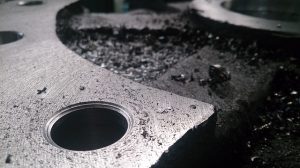
Milling and grinding are two common machining processes performed in the manufacturing industry. They both involve the removal of material from a workpiece, and they both support a wide variety of materials. Whether a workpiece is made of iron, aluminum, steel, copper or any other metal or alloy, it can probably be manipulated via milling or grinding. Milling and grinding aren’t the same, however. They each work in a different way to remove material from a workpiece.
What Is Milling?
Milling is a machining process that involves the use of a milling machine to remove material from a workpiece. Milling machines feature cutting blades that rotate while they press against the workpiece. The workpiece is secured in place so that it doesn’t rotate or otherwise rotate. During operation, though, the milling machine will press a rotating cutting tool against the stationary workpiece. As the cutting tool moves across the workpiece, it scraps off material, resulting in a smaller size.
Milling can be classified as either face or peripheral, depending on the position of the cutting tool. Face milling involves a cutting action at the corners of the cutting tool, whereas peripheral milling involves a cutting action that runs the circumference of the cutting tool. Peripheral milling is typically used for cutting deep slots and gear teeth.
What Is Grinding?
Grinding, on the other hand, is a machining process that involves the use of a disc-shaped grinding wheel to remove material from a workpiece. There are several types of grinding wheels, some of which include grindstones, angle grinders, die grinders and specialized grinding machines. Regardless of the grinding wheel, though, all grinding processes use abrasive particles to “grind” away material from a workpiece’s surface.
When a workpiece is exposed to a grinding wheel, some of its material will rub off. With that said, grinding is often used to both remove material from workpieces as well as polish workpieces. If a workpiece has a coarse surface, grinding can make it smoother. The abrasive particles on the grinding wheel will smooth and, therefore, polish the workpiece’s surface.
In Conclusion
While they both involve the physical removal of material from a workpiece, milling and grinding aren’t the same. The former machining process is characterized by the use of a milling machine, whereas the latter machining process is characterized by the use of a grinding wheel.
